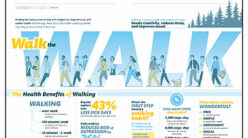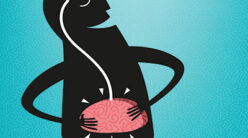 Between 50 and 70 million Americans suffer from headaches each year. Many of those headache sufferers often turn to medication or retire to a dark room waiting for the pain to go away. However, other headache sufferers are finding relief by taking a proactive approach. Before headaches strike, they engage in aerobic exercise.
Between 50 and 70 million Americans suffer from headaches each year. Many of those headache sufferers often turn to medication or retire to a dark room waiting for the pain to go away. However, other headache sufferers are finding relief by taking a proactive approach. Before headaches strike, they engage in aerobic exercise.
Their results are impressive: people who engage in aerobic exercise get fewer headaches, their headaches are less severe, and they have less of a need for serious drug-therapy programs. “People who regularly walk briskly or jog have reported dramatic improvements in their headaches,” declare Dr. Alan M. Rapoport and Dr. Fred D. Sheftell, founders and directors of the New England Center for Headache in Stamford, Connect-icut, and authors of several books about headaches.
An increasing body of scientific evidence points to the fact that exercise is the best medicine. For example, a recent Consumer Reports survey of more than 46,000 people found exercise to be almost as effective as–and sometimes more effective than–prescription medications for nonmedical problems. Participants also favored exercise over many alternative therapies, such as massage, herbs, and acupuncture. In the study exercise scored better than other natural remedies for allergies, depression, high cholesterol, insomnia, and respiratory infections. Here are 10 other reports that clearly show that exercise is a natural remedy that really works:
1. If you’re a woman, you can leave the blues behind.
When mild depression strikes, one of the most effective antidotes is to lace up your sneakers. Researchers studied more than 7,000 people and found that women who logged more than 11 miles a week exercising on foot were less likely to feel depressed or have symptoms of depression such as feeling sad, fatigued, worthless, or unable to think or concentrate. And all it took to fill that prescription was three miles four days a week. It didn’t seem to matter how those miles were covered. Walk-ing, jogging, and running all seemed to produce the same “mood-lifting” benefit. Other studies demonstrate that exercise is a mood elevator for men as well as women.
2. If you’re a man, exercise makes you feel young and “frisky” again.
Recently British researchers compared 10 men, (55 to 65 years of age) who ran at least 40 miles a week with 10 sedentary men of the same age. They found that the runners had higher levels of certain hormones. Testoster-one was 25 percent higher. The growth hormone, which helps maintain muscle and bone, was four times higher. The London study author, Steven Hurel, Ph.D., says that any level of regular exercise can produce similar benefits for men.
3. Exercise can slow, stop, and even reverse clogged arteries.
Louis Harris, the noted pollster and public-opinion analyst, enjoyed good health until he was 72 (often competing in tennis against people 30 years younger). “I thought I was immune to the gradual physical decline that age seemed to inflict on others,” he says. Then during a tennis game as he raced in to return the ball, a burning, knifelike pain suddenly shot into both his calves. It spread up to his thighs, and his legs went numb. Although that incident passed, Louis discovered that he could walk only two city blocks before his feet tingled and grew numb and his legs cramped with excruciating pain.
Consulting a vascular surgeon, Harris learned he had occlusions in the femoral arteries of both legs. It was caused by a buildup of plaque that extended all the way up to his aorta. Although surgery could correct the problem, the doctor strongly recommended Harris begin walking at least one mile every day.
“I think your body will cure the clogged-artery problem by itself,” the surgeon said. He explained that daily walking would prompt the muscles to send out signals for more blood flow. Very slowly, over time, the body would respond by making new arteries called collaterals. Those collaterals would bypass the blocked arteries just as surgery would. “It may take more than a year to grow new collaterals, but you can do it,” he advised Harris.
Harris began walking. Although it was extremely difficult, he struggled by walking in two-block increments and then resting. He persevered and was soon able to walk several miles at a time. Harris never needed the surgery. One year later he said: “I have found a new purpose in life as well. I tell others who are in the predicament I was in to walk. They should ask their doctor whether they, too, could avoid invasive surgery by doing something as simple as walking. The healing powers of our bodies are there, just waiting to be used.”
4. For women, exercise reduces the risk of premenopausal breast cancer.
A study of more than 1,000 California women found that moderate but regular physical activity can reduce premenopausal breast cancer by as much as 60 percent. Women who exercised for four hours a week by engaging in such activities as jogging, swimming laps, or playing tennis had the greatest risk reduction. But even two or three hours of activity proved beneficial.
5. It’s heart smart.
By now everyone knows that exercise slashes the risk of developing heart disease. However, what is less well known is that recently the American Heart Association (AHA) upgraded physical inactivity from a “contributing factor” for heart disease and stroke to a “risk factor,” along with high blood pressure, cigarette smoking, and high blood cholesterol. Data from several major studies had been reviewed by AHA experts, and the evidence was there to elevate the risk, said Dr. Edward Cooper, AHA president and a professor at the University of Pennsylvania School of Medicine. Twenty to 30 percent of the U.S. population–50 to 75 million people–are so sedentary that they have a three to four times greater risk for developing heart disease than do their more active counterparts. According to AHA research, exercise can help control cholesterol, obesity, high blood pressure, and diabetes. As a result, the new AHA position statement strongly recommends 120 to 160 minutes per week of activities, such as brisk walking, hiking, jogging, swimming, and tennis.
6. You’ll change your biological age.
Aging athletes keep their circulation young. The blood vessels of older athletes behave like those of people half their age, according to a new study released by the American Heart Associa-tion. Researchers studied athletes and nonathletes, both young and old. The average age for both of the younger groups was 27. The average age for the older group of nonathletes was 63, and the older athletes averaged 66. The study found that the older athletes’ blood vessels functioned as well as those of the participants in either of the two younger groups. Researchers found that exercise helps the arteries relax and makes them far more able to expand, preventing arterial stiffness, which can lead to cardiac problems. Older athletes also had lower levels of free radicals, which are unstable reactive oxygen molecules that circulate in the blood and damage tissues. These reactive molecules play a major role in the formation of artery-blocking fatty buildup when they come in contact with LDL cholesterol–the “bad” cholesterol.
7. You can walk off chronic fatigue syndrome.
An increasing number of people are being diagnosed with chronic fatigue syndrome (CFS). Symptoms include feeling weary to complete exhaustion and inability to function well on daily tasks. Because the origin of CFS is uncertain, its treatment is equally unclear. However, a new study offers hope that for some CFS patients, the road to recovery is exercise. In a study at St. Batholomew’s and the Royal London Medical School in Britain, researchers enrolled 66 patients in a 12-week program of either aerobic exercise (five days a week) or flexibility training. By the end of the study, twice as many of the exercisers rated themselves as feeling better, compared with those in the flexibility group. The exercising group also showed more improvement on measurements of fatigue.
8. Pumping iron eases arthritis pain.
“I am 42 years old, and 10 years ago I was diagnosed with scoliosis [a curvature of the spine] and later developed arthritis. I suffered terrible pain and tried a variety of therapies and treatments,” says Jeanie Bruneau of Courte-nay, British Columbia. “One day, out of desperation, I decided to take control of my life. I started working out with low weights–working through the pain–and as my pain started to go away I increased the weights. It’s two years later, and I not only feel great, but I look great too. It was the best decision of my life,” she adds.
9. You can walk away from a winter cold.
Although there is not yet a cure for the common cold, medical researchers have discovered one way to avoid it: outwalk it. Exercise–even the moderate kind recommended to reduce the risk of heart disease and other serious ailments–now looks like a powerful weapon in the everyday battles against colds and flus as well.
David Nieman, a public health researcher at Appalachian State University in Boone, North Carolina, tested women in their 30s and found that those who walked briskly for 45 minutes a day, five days a week, were sick with colds for only five days during the 15-week study period. Their sedentary peers, on the other hand, sported colds of one kind or another for 10 days. Four years later Nieman repeated the study, but this time used women over 60 years of age. Half of them walked 37 minutes per day, five days per week, for 12 weeks. Half of the nonexercisers caught colds, but among the walkers, only 8 percent got sick.
10. Exercise, and you will live longer.
A vigorous half-hour walk six times a month can dramatically reduce the risk of premature death, even taking into account genetic factors, according to a recent article published in the Journal of the American Medical Association. Vigorous walkers had a 43 percent lower risk of premature death when compared with those who were sedentary, according to the study, which tracked about 16,000 healthy men and women from a national registry of twins in Finland. By studying twins, that report is among the first studies to separate the influence of exercise and genetics, and clearly suggests that even moderate exercise can greatly enhance longevity. The study, which began in 1975, demonstrated that even occasional exercisers had a 29 percent reduced risk of premature death compared with those who did not exercise at all.







2 thoughts on “Why Exercise is the Best Medicine”
Hameed From Exercise & Workout Tips
(April 12, 2010 - 12:01 am)Excellent post. I suggest all of us print this article and hang it in a place where we can see it everyday, so that our motivation is up.
Secondly when most people think about exercise, all they think about is gym weights or treadmills!
So not true.
Think about swimming, hiking, or any sport you like. Although weight training and cardio should be form the base of your exercise program, seasonal sports should be included to give us a break and help us recover from regular exercise training.
Cheers.
lilly
(June 21, 2010 - 8:14 am)I agree with the headaches. There was a time that I was unable to do my yoga routine for a few days when I started to feel dizzy sometimes I thought I was having a migraine for consecutive days already. So I made sure that I do my yoga the next day, and voila! The headaches were gone. 🙂
Comments are closed.